On Monday, the Supreme Court will hear oral arguments in the case of Damon Landor, a Louisiana man whose religious beliefs led him to grow long dreadlocks. The case raises significant questions regarding the balance between institutional authority and individual rights, particularly in the context of religious expression within the prison system. Landor’s situation began in 2020 when prison officials forcibly shaved his head, disregarding a federal appeals court ruling that affirmed his right to maintain his dreadlocks.
The Legal Framework: RLUIPA
At the heart of this case is the Religious Land Use and Institutionalized Persons Act (RLUIPA), a federal law enacted 25 years ago. This legislation applies to state prisons that receive federal funding and prohibits the government from imposing a substantial burden on an individual’s religious exercise unless it is the least restrictive means of achieving a compelling government interest. Furthermore, RLUIPA permits individuals to file lawsuits against government officials for violations, seeking “appropriate relief” for such infringements.
RLUIPA was introduced as a response to the limitations imposed by the Supreme Court’s decision in Employment Division v. Smith, which held that the First Amendment does not exempt individuals from complying with neutral laws applicable to everyone. Following this, the Religious Freedom Restoration Act (RFRA) was enacted to provide broader protections but was later limited by the Supreme Court to only apply at the federal level. Consequently, RLUIPA emerged as Congress’s attempt to enhance protections at the state level.
Landor’s Religious Commitment
Damon Landor is a devout Rastafarian who has adhered to the Nazarite Vow, a commitment that requires him to grow his hair without cutting it, for nearly 20 years. His dedication to this vow underscores the importance of religious identity and expression in his life. Just three weeks before completing a five-month sentence in the Louisiana prison system, Landor was transferred, leading to the forced shaving of his dreadlocks, which he argues is a violation of his religious rights.
As the Supreme Court prepares to deliberate on this case, the implications extend beyond Landor’s personal situation. The outcome may set a significant precedent regarding how religious liberties are protected within correctional facilities. The justices must consider whether prison officials acted within their rights or whether they overstepped their authority by disregarding Landor’s religious beliefs.
Potential Impacts of the Decision
| Aspect | Potential Impact |
|---|---|
| Prison Regulations | May require reevaluation of policies related to religious expression |
| Legal Precedents | Could influence future cases involving religious rights in prisons |
The implications of this case could resonate through the legal system, potentially changing how courts interpret religious rights within institutional settings. As noted in discussions surrounding free speech rights, the balance between institutional authority and individual liberties remains a contentious area of law. The justices will need to weigh these considerations carefully as they approach their decision.
Furthermore, the case highlights the challenges of navigating multidistrict litigation in matters concerning religious freedoms. As the court examines the nuances of Landor’s claims, the broader implications for religious expression in correctional facilities will be closely monitored by legal experts and advocates alike.

The ongoing case of Damon Landor has drawn significant attention as it raises important questions regarding the intersection of religious liberty and institutional regulations. Landor, a Louisiana inmate, claims that his rights were violated when prison officials forcibly shaved his head, despite his adherence to a religious practice that requires him to maintain long dreadlocks. This legal battle not only highlights individual rights within the prison system but also examines the implications of federal laws designed to protect religious freedoms.
The Religious Land Use and Institutionalized Persons Act
At the heart of Landor’s case is the Religious Land Use and Institutionalized Persons Act (RLUIPA), a federal statute that was enacted to safeguard the religious practices of individuals in state prisons and other government-run institutions. RLUIPA prohibits the government from imposing a substantial burden on religious exercise unless it demonstrates that such action is the least restrictive means to achieve a compelling government interest. This law empowers individuals to seek court challenges against governmental actions that infringe upon their religious rights.
RLUIPA was established in response to the limitations placed on the Religious Freedom Restoration Act (RFRA) by the Supreme Court in 1997. Initially, RFRA was intended to provide broad protections for religious exercise across all government levels, but the ruling narrowed its applicability to federal entities. Consequently, RLUIPA was designed to reinforce protections at the state level, thereby ensuring that inmates like Landor can assert their rights without undue interference from prison authorities.
Landor’s Religious Practices and the Legal Implications
Damon Landor identifies as a devout Rastafarian and has committed to a religious vow known as the Nazarite Vow, which includes the practice of growing his hair without cutting it. This vow is deeply significant to him and represents a long-standing commitment to his faith. However, the forced shaving of his head just weeks before the completion of his sentence raises critical questions about the extent to which prison officials can infringe upon an inmate’s religious practices. The legal ramifications of this case could set a precedent for how similar cases are handled in the future.
As the Supreme Court prepares to hear oral arguments, the justices will need to consider whether Landor can seek monetary damages from the officials involved in this incident. The outcome of this case may influence how AI in courtrooms and other evolving legal standards intersect with established religious freedoms. The implications extend beyond this specific case, as they may affect the rights of other inmates facing similar challenges in asserting their religious beliefs.

In summary, the case of Damon Landor is not just about one man’s experience in prison; it encapsulates broader issues of religious freedom, institutional authority, and the legal frameworks that govern these interactions. The Supreme Court’s decision will be pivotal in defining the boundaries of religious expression within correctional facilities and may reshape the application of laws like RLUIPA in the years to come.
The upcoming Supreme Court case concerning Damon Landor underscores critical issues surrounding the intersection of religious liberty and state authority in prison settings. Landor’s experience highlights the complexities that arise when individual beliefs clash with institutional policies. As the justices prepare to deliberate, the implications of their ruling could resonate far beyond this particular case, shaping the landscape of religious freedoms for incarcerated individuals across the nation.
Background of the Case
Damon Landor, a Louisiana inmate and devout Rastafarian, has been embroiled in a legal battle following the forcible shaving of his dreadlocks by prison officials. This action was taken despite Landor presenting evidence of his religious rights, including a federal appeals court ruling that supported his claim to maintain his hair as part of his faith. Central to this case is the Religious Land Use and Institutionalized Persons Act (RLUIPA), a federal law designed to protect the religious freedoms of individuals in state prisons that receive federal funding.
RLUIPA, enacted 25 years ago, was a response to the limitations imposed by the Supreme Court’s decision in Employment Division v. Smith. In that ruling, the Court determined that the First Amendment does not provide an exemption for individuals from complying with generally applicable laws. Consequently, RLUIPA was introduced to ensure that any substantial burden on religious exercise could only occur if the government demonstrated it was the least restrictive means of achieving a compelling interest. This legal framework allows individuals to seek appropriate relief from government actions that violate their religious rights.
Implications of the Ruling
The Supreme Court’s decision in Landor’s case could set a significant precedent regarding the treatment of religious practices within correctional facilities. If the Court rules in favor of Landor, it may affirm the rights of inmates to freely exercise their religion, potentially leading to broader interpretations of RLUIPA and similar laws. Conversely, a ruling against Landor could reinforce the authority of prison officials to impose restrictions on religious practices, raising concerns about the protection of individual liberties within the penal system.

Moreover, the outcome of this case could influence future legislation and litigation related to religious freedom in various institutional settings. As the legal landscape evolves, it is essential for lawmakers and prison administrators to balance security concerns with the constitutional rights of individuals. The implications of the ruling will likely extend beyond the immediate parties involved, impacting the broader discourse on religious liberty and institutional policies.
Broader Context of Religious Liberty
The tension between religious liberty and governmental authority is a longstanding issue in American jurisprudence. The enactment of RLUIPA was an effort by Congress to rectify perceived deficiencies in the application of the Religious Freedom Restoration Act (RFRA), particularly after the Supreme Court limited RFRA’s applicability to federal actions. RLUIPA sought to ensure that state-level protections for religious exercise were robust and enforceable.
As the Supreme Court hears arguments in Landor’s case, it will confront fundamental questions about the extent of religious freedom within the prison system. The Court’s ruling will not only impact Landor but also serve as a touchstone for future cases involving the rights of incarcerated individuals. The balance between maintaining order and respecting individual beliefs remains a contentious issue, and the resolution of this case will undoubtedly contribute to ongoing debates about religious liberty in America.
Ultimately, the outcome of this case will be crucial in determining how religious rights are upheld in correctional facilities. The Court’s decision will provide guidance on the extent to which prison regulations can restrict religious practices and the standards required for proving a substantial burden under RLUIPA. As such, all eyes will be on the justices as they deliberate on these pressing issues, which have significant implications for the future of religious liberty in institutional settings. For further context on legal protections, visit legal protections related to institutionalized individuals.